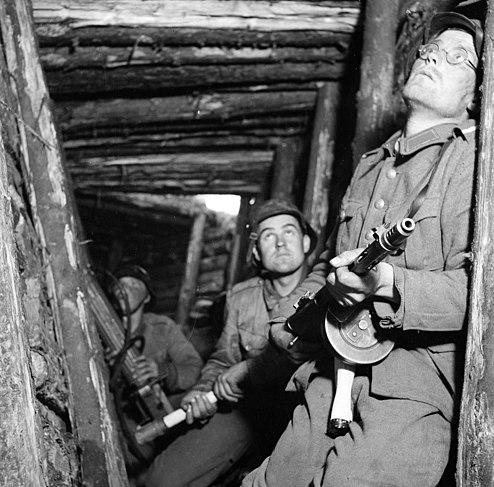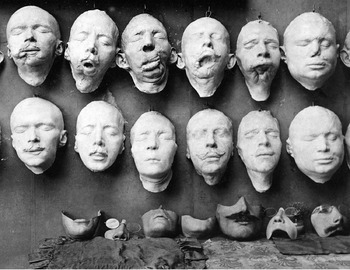The Confederacy's Revenge: How Japan's Superbomb Project Succeeded With FitzBelmont
Henderson V. FitzBelmont, a Confederate Physicist who developed the first superbomb used against the United States*
If you were to read any history book about the Second Great War, you will often see the names of those scientists who were involved in their respective country's superbomb project: The German Einstein, The English
Chadwick, and the American
Oppenheimer. While there were other minor figures involved, one name tends to be mentioned much more rarely than others: FitzBelmont.
Dr. Henderson V. FitzBelmont was born during the Confederacy's 80+ year old existence and was head of the superbomb project located in Lexington, Virginia at Washington University. In 1944, the Confederates were able to successfully create a functioning superbomb and used it against Philadelphia during Potter's Raid. However, it was not as strong as the other superbombs that were detonated in Europe and only affected the western part of Philadelphia; the opposite side of where most of the U.S. government functioned. FitzBelmont was captured by U.S. forces, interrogated, and eventually released from custody. While he was able to return to Lexington and continue his academic teaching, the professor disappeared some time after the end of the war. No trace of him was ever found and it was suspected that the U.S. government played a role in his disappearance.
Many decades later and as the 20th Century reaches its last years, a new book was released in the Japanese Republic, in collaboration with other research scholars from different countries, that revealed how the Empire of Japan was able to advance their own superbomb project with the help of FitzBelmont's written work that was eventually received by Dr.
Bunsaku Arakatsu.
Arakatsu was a Japanese Physicist who worked in a superbomb research program called
F-Go Project. He personally knew FitzBelmont and would occasionally correspond with him via letters. More than a year after the war had ended, Arakatsu received a collection of papers from the Royal and Pontifical University of Mexico**. The papers were initially sent by FitzBelmont first to the Second Republic of Texas in the hands of a group of secret Confederate sympathizers, and later to the Imperial District of Mexico where he knew and mentored to a few professors of Physics before the war started. The professors in Mexico were able to sent those papers to Japan in accordance to the written request that existed within the rest of the papers. The FitzBelmont Papers, as they are now called, contained crucial information about the Confederacy's superbomb program, such as how to successfully built one. With the help of Dr.
Yoshino Nishina, Arakatsu was able to convince the Imperial government of Japan to invest more resources to their own superbomb project. On August 27, 1947***, the world reacted with surprise when the Japanese detonated its first superbomb on Karafuto island. The accelerated success of Japan's kernweapon
s**** program was credited to the information that FitzBelmont was able to send out before his disappearence.
Despite all this incredible information, there wasn't much of an answer as to what happened to FitzBelmont. According to the book, the U.S. government was undecided on what to do with FitzBelmont. General Abell expressed interest in liquidating him, but the government eventually decided to keep him under U.S. control and have him be part of creating more superbombs for the United States. However, the last known sighting of him was when he was heading to the Second Texas Republic to visit a university. Based on some of the personal writing that could be found, FitzBelmont expressed dissatisfaction in working with the American government. He hated Featherston for what he had done to the CSA, but refused to be a "white slave" for the "Yankee government" and would prefer to die than continue to live in a world without the CSA.
The research team for the book concluded that FitzBelmont may have taken his own life somewhere near the Texan-Mexican border, but this was never proven. A few members of the team think that he either lived a secret life under a new identity in Texas or in Mexico.
Inspiration:
https://www.latimes.com/world/asia/la-fg-japan-bomb-20150805-story.html
*I used OTL's
Franco Rasetti as a TL-191 look-alike for FitzBelmont.
**The university was disbanded in 1865 by Maximilian. However, I think that a successful installation of the Second Mexican Empire may have resulted in the university being kept. Today the university eventually became OTL
UNAM.
https://books.google.com/books?id=ajwABAAAQBAJ&pg=PA139&dq=maximilian+"30+november+1865"&hl=en&sa=X&ved=0ahUKEwjyo9yOlJrPAhUHzIMKHWJ2BHkQ6AEIGzAA#v=onepage&q=maximilian "30 november 1865"&f=false
https://books.google.com/books?id=klc_AQAAMAAJ&q=maximilian+"30+november+1865"&dq=maximilian+"30+november+1865"&hl=en&sa=X&ved=0ahUKEwjyo9yOlJrPAhUHzIMKHWJ2BHkQ6AEISTAI#v=snippet&q=maximilian "30 november 1865"&f=false
***A similar event that is related to OTL's
first nuclear bomb detonated by the Soviet Union.
**** A German-influenced word for "nuclear weapons" that I made up. In German, nuclear weapons are called
kernwaffe.
Bonus: Using the Hiroshima bomb in OTL as an example, you can find out how big the blast radius would have been if it was detonated in Philadelphia. I assume that the Confederate bomb in TL-191 would be smaller by comparison. Here is the website:
https://nuclearsecrecy.com/nukemap/







